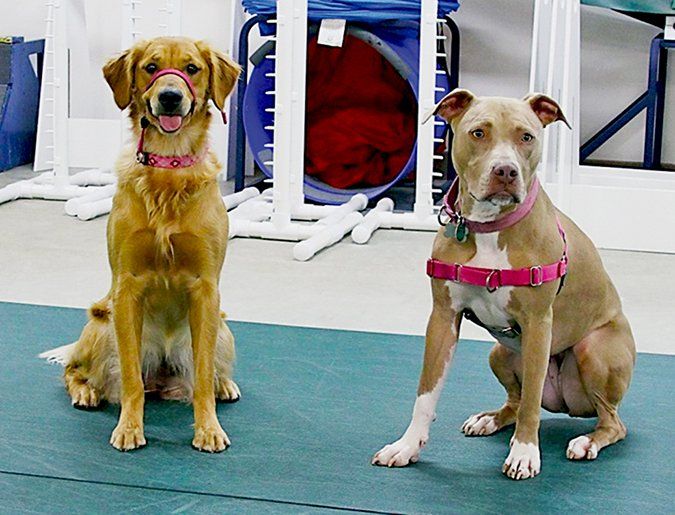Our youngest dog, Ally, has a “bestie.” Her name is Colbie and she belongs to our friend Amanda, a trainer who also works as an instructor at my training center, AutumnGold. Ally is a Golden Retriever. Colbie is a pit bull, adopted from a local shelter while Amanda was on staff there.
Being young girls, both Ally and Colbie wear pink collars, Gentle Leaders, and harnesses. For Ally, this is simply a fashion statement. For Colbie, given her breed and the breed stereotypes that she may encounter, it means a bit more. Amanda purposefully dresses Colbie in pink, hoping that such feminine attire will present Colbie as the sweetheart that she is.
Although Ally does not care about Colbie’s genetic heritage (or that she wears pink), many people do. Breed stereotypes are pervasive and impact local and state breed-specific legislation (BSL), homeowner’s insurance rates, rental property regulations, and shelter decisions regarding adoption and euthanasia. BSL in the United States and the United Kingdom specifically target pit bulls and other bully-type breeds, and either ban ownership of the breeds outright or impose strict restrictions upon ownership. These laws are based upon two assumptions:
1. Targeted breeds are inherently dangerous.
2. Individuals of the breeds can be reliably identified.
There is much controversy (and no consensus) regarding the first assumption, which is a topic for another time.
In this article, we look at the second assumption regarding reliable breed identification. Is there supporting evidence?
It turns out that there is quite a bit of science on this topic – and the results are quite illuminating.
A Dog Breed Guessing Game
Prior to the development of DNA testing, the only method available for identifying the breed of a dog whose heritage was unknown was visual assessment. A shelter worker, veterinarian, or animal control officer examines the dog and assigns a breed designation based upon physical appearance and conformation. Even with widespread availability of DNA tests, most shelters and rescue groups continue to rely upon visual identification to assign breed labels to the dogs in their care. Given the life or death import of these decisions for some dogs, it is odd that the question of the reliability of these evaluations has not been questioned.
Until recently.
Even the Experts Can’t Agree on Pit Bulls
In 2013, Victoria Voith and her co-researchers (reference 1) asked more than 900 pet professionals to assign a breed (or mix of breeds) to 20 dogs that they viewed on one-minute video clips. A DNA test was conducted for each of the dogs prior to the study, which allowed the researchers to test both the accuracy of visual breed-identification and the degree of agreement among the dog experts.
Results: Poor agreement was found between visual breed assignments and DNA results in 14 of the 20 dogs (70 percent). Moreover, there was low inter-rater reliability, meaning that the dog experts did not show a high level of agreement regarding breed assignments to the 20 dogs. More than half of the evaluators agreed on the predominant breed in only seven of the 20 dogs (35 percent). These results provide evidence that physical appearance is not a reliable method for breed identification.
You Say Pit Bull, I Say Boxer
The following year, researchers in the U.S. and the U.K. collaborated and examined the consistency with which shelter workers assigned breed labels to the dogs in their care (reference 2). A group of 416 shelter workers in the U.S. and 54 in the U.K. were asked to assign a breed or mix of breeds to photographs of 20 dogs. They also completed a questionnaire that asked them to list the specific features that they used in their determination. Of the 20 dogs that were used in this study, more than three-quarters had a bully-breed appearance.
Note: An important difference between the U.K. and the U.S. is that all U.K. shelters are subject to the country’s Dangerous Dog Act, a law that bans the ownership of pit bulls. While such bans exist in the U.S., there is no universal law. Rather, select municipalities or states have various forms of BSL.
Results: Perhaps not surprisingly, U.K. shelter workers were much less likely to identify a dog with a “bully appearance” as a pit bull than were U.S. shelter workers. Instead, the U.K. shelter workers tended to label these dogs as Staffordshire Bull Terriers, a breed that is allowed in the U.K., rather than as a pit bull, a “breed” that is universally banned.
Despite this difference, results corroborated Voith’s study in that the researchers found a great deal of variation among shelter workers in their assignments of breed, and there was a lack of consensus regarding which of the 20 dogs were identifiable as pit bulls.
DNA VS. Shelter Staff
A 2015 study surveyed experienced shelter staff members at several Florida animal shelters (reference 3). At each of four sites, four staff members were asked to assign breed designations to 30 adoptable dogs who were housed at their shelter. Collectively, 120 dogs were evaluated by 16 staff members. DNA testing was conducted on all of the dogs. A primary objective of this study was to examine the reliability of shelter staff’s ability to identify dogs with pit bull heritage and to compare their assessments with DNA results.
Note: The DNA signatures that are used to identify “pit bull terriers” are those of the American Staffordshire Terrier and the Staffordshire Bull Terrier, two breeds that are considered to be genetically identical. The companies that offer DNA tests for mixed-breed identification do not include American Pit Bull Terriers among the breeds they may identify.
Results: About one-third of the dogs who were identified as a pit-bull type breed by one or more shelter staff lacked any DNA evidence of bully breeds in his/her heritage. When inter-rater reliability among the participants was examined, agreement among shelter staff was moderate, but still included a relatively large number of disagreements.
What this means in practical terms is that a substantial number of dogs in this study were labeled as pit bulls or pit bull types and yet had no such genetic background. Even if the shelter staff agreed on a particular dog’s identification, this would be rather a moot point (for the dog) if they both happened to be wrong.
Breed DNA Doesn’t Always Show
How is it possible that a dog who appears to have the characteristic “pittie-type” head shape, muscular body, and other distinctive features, tests negative for pit-bull heritage? The conclusion that many people make from these discrepancies is that DNA testing must be unreliable, inaccurate, or just plain wrong.
However, the fact is that it is not uncommon for the results of DNA tests of dogs who have mixed heritage to identify a set of primary ancestor breeds that look nothing like the dog in question. This occurs because purebred crosses, particularly after the first generation, can result in unique combinations of genes that produce a wide range of features. When several different breeds are involved, some of these features may not be apparent in any of the ancestral breeds.
This occurs for two reasons. First, many of the breeds that we know today were originally created by crossing two or more existing breeds and then selecting for a small set of physically unique traits in subsequent generations. However, the dogs of these breeds still carry genes for a much wider variety of traits, even though the genes are not being “expressed” in the dog’s appearance. When these dogs are then bred to dogs of other breeds the hidden traits may become evident in their puppies.
A second reason is that less than one percent of the canine genome encodes for breed-specific traits such ear shape, coat type and color, and head shape. So, a dog could be a large part (genetically) of a certain breed, while not showing all of the breed’s physical traits, which may have been rapidly lost during cross-breeding with other breeds.
These three studies provide valuable evidence that the use of visual assessments to assign breed or breed-mixes to dogs is inaccurate and unreliable.
Not to put too fine a point on it, but this information is of more than just casual interest for dogs like Colbie because pit bulls and other “bully breeds” are most frequently stigmatized by breed stereotypes and impacted by BSL and shelter policies that require automatic euthanasia. It is not an exaggeration to suggest that identifying an individual dog as a pit bull may be a matter of life or death for that dog.
Labels Matter in the Pet Adoption World
A recent paper published by researchers in Clive Wynne’s dog lab at the University of Arizona describes an ambitious series of experiments in which they examined the impact of breed labels on the perceptions of potential adopters and on the eventual outcome for the dog (reference 4). The studies were carried out online and at animal shelters in Florida and Arizona. Participants were asked to rate photographs, videotapes, or live dogs in their kennels. In some conditions the dogs were provided with a breed label and in others they were not.
Results: Two major findings came out of these studies. The first showed that stereotypes about pit bulls are alive and well, and the second showed how this stigmatization ultimately affects dogs:
1. People rated an image of a “pit-bull type” dog as less approachable, friendly, and intelligent, and more aggressive when compared to an image of either a Labrador Retriever or a Border Collie. In another experiment, labeling a dog as a pit bull negatively influenced the perceptions that people had about the dog. When visitors rated a dog who was labeled as a pit bull, the dogs were found to be less attractive in terms of perceived approachability, friendliness, intelligence, aggressiveness, and adoptability compared with when the same dog was not so labeled.
2. Dogs who had been labeled as pit bulls had length of stays in the Florida shelter prior to adoption that were more than three times as long as the stays of dogs who were matched in appearance, but had been labeled as another breed or breed-mix.
When breed labels were removed from the profile cards of dogs offered for adoption, adoption rates for pit bulls increased significantly, length of stays prior to adoption in the shelter decreased, as did euthanasia rates.
Interestingly, not only pit bull-type dogs benefited from removing breed labels from the kennel cards. Dogs from working breeds who were available for adoption, in particular Boxers, Dobermans, and Mastiffs also showed an increase in adoption rate.
Take Away Points
There is a lot to ponder here. We have learned that breed identification using a dog’s physical appearance, even when conducted by experienced dog experts, is flawed in two distinctive ways. First, experts cannot agree consistently about how to label an individual dog. One person’s Boxer-mix is another’s pit bull and is yet another’s Bulldog/Lab mix.
Second, DNA tests do not consistently confirm breed assignments that were based upon physical appearance. Labeling breeds for purposes of shelter retention, adoption, and euthanasia is a highly dubious process, and one that is most critical for pit bulls, American Pit Bull Terriers, Staffordshire Bull Terriers, and every other so-called “bully” breed and breed-mix.
We have also learned that potential adopters react to a pit bull label in ways that may adversely affect the outcome for the dog. Labeling a dog as a pit bull may increase her length of stay in the shelter, reduce her chances of adoption and increase her risk of being killed, simply because she was assigned a (possibly incorrect) label that changed the perceptions of potential adopters.
And last, we have evidence that removing breed labels from the cage cards of adoptable pit-bull-type dogs (and many other dogs) increases their chance of adoption, reduces the length of their stay in the shelter, and increases their chance of simply staying alive.
Colbie is pretty in pink, for sure. But it’s time that wearing pink becomes a simple fashion statement for Colbie, just as it is for her pal Ally.
What’s a “Pit Bull” Anyway?
Would it surprise you to learn that there is no such breed as the pit bull? This is why it’s not capitalized in WDJ; we do capitalize breed names. There are lots of dogs that are called “pit bulls,” however. Some of them might actually be one of these: The American Kennel Club (AKC) recognizes a breed called the American Staffordshire Terrier, and another called the Staffordshire Bull Terrier. The United Kennel Club (UKC), established in 1898, recognized its first breed, the American Pit Bull Terrier, in 1898. The UKC also recognizes the Staffordshire Bull Terrier. Pedigrees be damned, an individual of any one of these dogs would likely be labeled as a “pit bull” if he or she were found in an animal shelter.
As the studies discussed here show, the above-mentioned purebreds, as well as other breeds developed over the years (including the American Bulldog) – and the countless mixed-breed dogs that result from matings with them – are largely indistinguishable to most humans, and even to many dog training or veterinary professionals. If the dog has a blocky head, a muscular body (whether it’s short and squatty, or taller and chiselled), a short coat, and a whippy tail, he will likely be called a pit bull at some point – almost certainly if he ends up in a shelter. If he’s lucky enough to make it onto the adoption row and gets adopted, his savior finds she has also adopted a quandary: Most breed specific legislation, housing regulations, and insurance companies discriminate against any dog with a “pit bull” label – possibly the reason why those mixed-breed DNA testing companies don’t designate any of the dogs they test as American Pit Bull Terriers.
– Nancy Kerns
Linda P. Case, MS, owns AutumnGold Consulting and Dog Training Center in Mahomet, Illinois. She is the author, most recently, of Beware the Straw Man (2015) and Dog Food Logic (2014), and many other books about dogs. See her blog at thesciencedog.wordpress.com.
Cited References
1. Voith VL, Trevejo R, Dowling-Guyer S, Chadik C, Marder A, Johnson V, Irizarry K. “Comparison of visual and DNA breed identification of dogs and inter-observer reliability.” American Journal of Sociological Research 2013; 3:17-29
2. Hoffman CL, Harrison N, Wolff L, Westgarty C. “Is that dog a Pit Bull? A cross-country comparison of perceptions of shelter works regarding breed identification.” Journal of Applied Animal Welfare Science 2014; 17:322-339
3. Olson KR, Levy JK, Borby B, Crandall MM, Broadhurst JE, Jacks S, Barton RC, Zimmerman MS. “Inconsistent identification of pit bull-type dogs by shelter staff.” The Veterinary Journal 2015; 206:197-202
4. Gunter LM, Barber RT, Wynne CDL. “What’s in a name? Effect of breed perceptions & labeling on attractiveness, adoptions & length of stay for pit-bull-type dogs.” PLoS ONE 2016; 11:e0146857.doi:10.1371/journal.pone.0146857







Correction re: end section on pit bull labeling and breed names: As of February 2019, Embark did in fact use the label “American Pit Bull Terrier” in our DNA results for my dog’s mix. They provide the breed’s specific profile when that breed shows in breed test results. The profile includes the favorable traits of the breed and commentary about its controversial history.